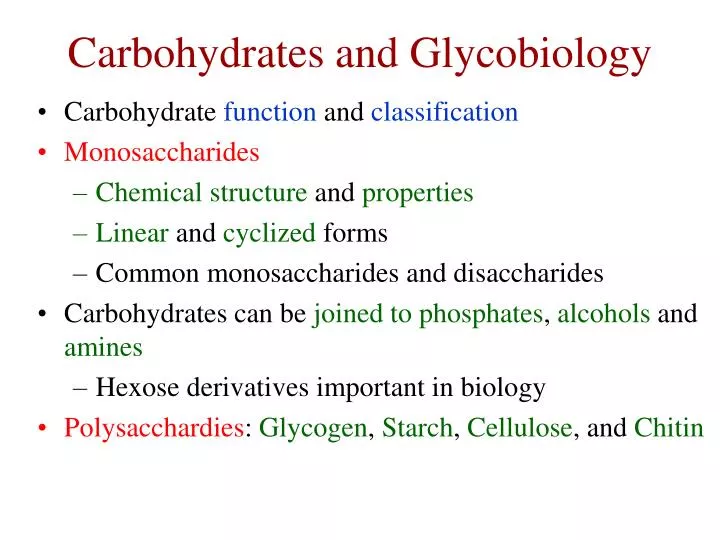
Unsaturated A puzzle: Slide 37 Trans fats Phospholipids Steroids Fake fat Slide 42 A fatty acid consists of: Why can’t you mix oil and water Which of these is the largest object23.1: Classification of Carbohydrates. Slide 30 Lipids Slide 32 Slide 33 Slide 34 Saturated vs. Complex carbohydrates are: True or false: Sugars and starch have a lot of fat in them.
They are composed of carbon and water and have a composition of (CH2O)n. Disaccharides: two.2 Definition Carbohydrates are essentially hydrates of carbon (i.e. Monosaccharides: one carbohydrate unit.

Carbohydrates Ppt Free Chemistry PowerPoint
They can be classified by the number of. Complex carbohydrates can be broken down into smaller sugar units through a process known as hydrolysis. If there are not enough carbohydrates, then large amounts of fat are used for energy. For fat to be metabolized properly, carbohydrates must be present. Free Chemistry PowerPoint templates are made, while keeping in mind students who are Download free Chemistry PowerPoint templates to get an A+ grade in your presentation.

Example raffinose, which has molecular formula, C18H32O16.7 Classification Polysaccharides: The polysaccahrides are carbohydrates of high molecular weight which yield many monosaccharide molecules on hydrolysis. Examples are sucrose and maltose, both of which have molecular formula, C12H22O11.6 Classification (b) Trisaccharides, which yield three monosaccharide molecules on hydrolysis. They include, (a) Disaccharides, which yield two monosaccharide molecules on hydrolysis. Examples are glucose and fructose, both of which have molecular formula, C6H12O6.5 Classification Oligosaccharides: The oligosaccharides (Greek, oligo, few) are carbohydrates which yield a definite number (2-9) of monosaccharide molecules on hydrolysis.
Ketoses (e.g., fructose) have a keto group, usually at C2.11 D vs L Designation D & L designations are based on the configuration about the single asymmetric C in glyceraldehyde. Monosaccharides with three carbon atoms are called trioses, those with four are called tetroses, five are called pentoses, six are hexoses, and so on.Tetrose- Erythrose pentose- Ribose Hexose- Glucose, Fructose10 Monosaccharides Aldoses (e.g., glucose) have an aldehyde group at one end. If the carbonyl group is an aldehyde, the monosaccharide is an aldose if the carbonyl group is a ketone, the monosaccharide is a ketose.
Thus there are 16 stereoisomers (8 D-sugars and 8 L-sugars).14 The four & five carbon ketoses are designated by inserting ‘ul’ into the name of a corresponding aldose For example, D-ribulose is the ketopentose corresponding to the aldopentose D-ribose17 Two sugars that differ only in the configuration around one carbon atom are called epimersD-glucose and D-mannose which differ only in the stereochemistry at C-2 are epimers, as are D-glucose & D-galactose which differ at C-420 HAWORTH PROJECTION FORMULAS FOR SUGARS21 Monosaccharides have cyclic structuresIn aqueous solution, aldotetroses and all monosaccharides with five and more carbon atoms in the backbone occur predominantly as cyclic structures in which the carbonyl group has formed a covalent bond with oxygen of a hydroxyl group along the chain The formation of these ring structures is the result of a general reaction between alcohols and aldehydes or ketones to form derivatives called hemiacetal or hemiketalsAn aldehyde can react with an alcohol to form a hemiacetal. The 6-C aldoses have 4 asymmetric centers. The number of stereoisomers is 2n, where n is the number of asymmetric centers. Other stereoisomers have unique names, e.g., glucose, mannose, galactose, etc. They have the same name, e.g., D-glucose & L-glucose. Most naturally occurring sugars are D isomers.13 D & L sugars are mirror images of one another.
Like monosaccharides, disaccharides form an aqueous solution when dissolved in water. Haworth projections represent the cyclic sugars as having essentially planar rings, with the OH at the anomeric C1: a (OH below the ring) b (OH above the ring).27 Disaccharide A disaccharide is the carbohydrate formed when two monosaccharides undergo a condensation reaction which involves the elimination of a small molecule, such as water, from the functional groups only. The 2 stereoisomers are called anomers, a & b. These representations of the cyclic sugars are called Haworth projections.25 Fructose forms either a 6-member pyranose ring, by reaction of the C2 keto group with the OH on C6, or a 5-member furanose ring, by reaction of the C2 keto group with the OH on C5.26 Cyclization of glucose produces a new asymmetric center at C1Cyclization of glucose produces a new asymmetric center at C1. Glucose forms an intra-molecular hemiacetal, as the C1 aldehyde & C5 OH react, to form a 6-member pyranose ring, named after pyran.

The branches produce a compact structure & provide multiple chain ends at which enzymatic cleavage can occur.39 Glycogen Glycogen, the glucose storage polymer in animals, is similar in structure to amylopectin. Branches are generally longer than shown above. The end of the polysaccharide with an anomeric C1 not involved in a glycosidic bond is called the reducing end.38 Amylopectin is a glucose polymer with mainly a(14) linkages, but it also has branches formed by a(16) linkages. Amylose is a glucose polymer with a(14) linkages. Made of amylose and amylopectin. Occurs as granules in the cell.
The ability to rapidly mobilize glucose is more essential to animals than to plants. The highly branched structure permits rapid glucose release from glycogen stores, e.g., in muscle during exercise.


 0 kommentar(er)
0 kommentar(er)
